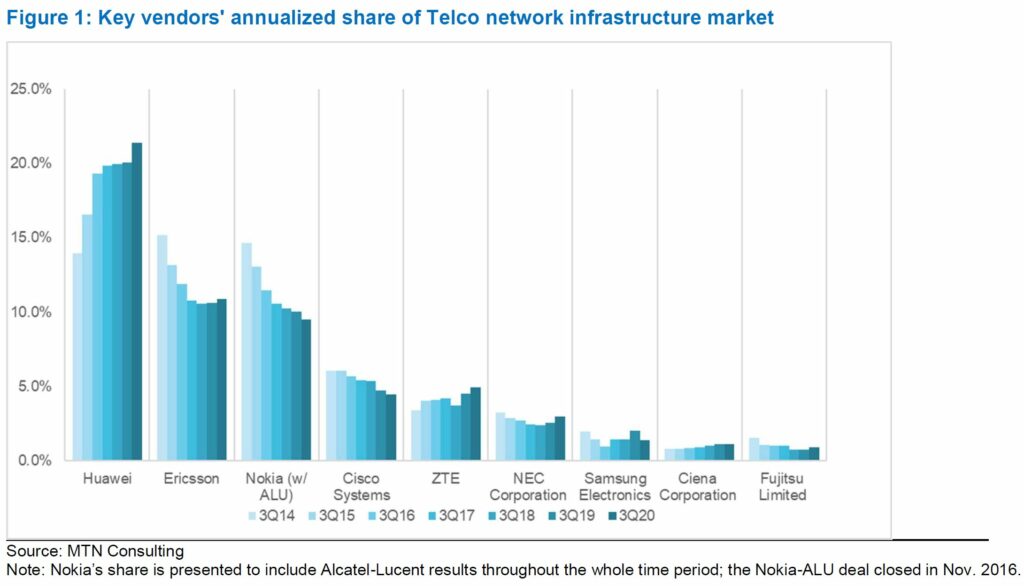By Matt Walker
The November 2020 election of Joe Biden to become the 46th President of the United States is having a number of sweeping effects. The most crucial one relates to the COVID-19 pandemic: Biden’s team has changed both tone and policy, and launched an aggressive, coordinated rollout of vaccines across the US population. Biden’s election will also have important impacts on communications network infrastructure markets, in at least two important ways.
First, US policy will continue to restrict much of the Chinese technology sector’s access to US supply chains; the US government will aim to minimize deployment of Chinese technology in both US communications networks and those in allied countries; and, US policy will support alternative technologies and companies that can help smooth the transition away from China. Implications: Huawei will see market share in the telecom sector decline markedly over the next 2 years; China will push harder on its own allies to purchase Huawei/ZTE gear; Huawei and ZTE will emphasize services and software more, and hardware less; China will explore many ways around the rules but see limited success without crucial chipmaking technology; Open RAN will see an accelerated adoption curve; US companies like Ciena, Cisco, and Infinera, and others (e.g. Fujitsu and NEC), will see telecom opportunities pick up significantly in 2H21 and 2022.
Second, the US will actively support the development of a semiconductor supply chain with more firm roots in the US mainland, and also aim to offset the growing global dependence on a single contract manufacturer (foundry), Taiwan-based TSMC. Implications: China will accelerate development of its own chipmaking industry and simultaneously use all means of political persuasion and bullying to bypass supply chain restrictions; Chinese hacking of the semiconductor sector will be more vigorous and aggressive than usual, both aimed at theft and at sabotage; China’s threats to invade Taiwan will get increasingly boisterous but not result in invasion through at least November 2022, instead remain aimed at extracting concessions; Intel and, to a much smaller extent, Samsung will benefit as the apparent risk of over-reliance on TSMC becomes clear; both US and European governments will focus R&D efforts at supporting alternatives to TSMC.
- Table Of Contents
- Figure & Charts
- Coverage
- Visuals
Table Of Contents
- Summary – page 2
- Huawei likely to fall below 20% share of telco network infra market in 2021 – 2
- US is poised to support semiconductor supply chain in big ways – 7
- Appendix – page 10
- About MTN Consulting
- Terms of Use
Figure & Charts
Figure 1: Key vendors’ annualized share of Telco network infrastructure market
Figure 2: Top 25 vendors in Telco NI Hardware/Software*: Annualized 3Q20 Revenues (US$B)
Figure 3: Price change for key chip players and NASDAQ, April 5, 2019 – March 15, 2021
Coverage
Companies and organizations mentioned in this report include:
Advanced Micro-Fabrication Equipment
AGCU Scientech
Airtel
Aksu Huafu Textiles
Alipay
AMD
Applied Materials
Arm Ltd.
Beijing University of Posts and Telecommunications
Beijing Zhongguancun Development Investment Center
CamScanner
China Communications Construction Company
China Electronics Technology Group Corporation, 7th Research Institute (CETC-7)
China National Aviation Holding
China State Shipbuilding
Ciena
Cisco
CloudWalk Technology
Commercial Aircraft Corporation of China
Dahua Technology
Deep Network Vision
Deutsche Telekom
DJI
Ericsson
Federal Communications Commission
FiberHome
Fujitsu
Global Tone Communication
GlobalFoundries
Gowin Semiconductor
Grand China Aie
Guangzhou Haige Communication Group Co., Ltd.
Hangzhou Hikvision
Hikvision
HiSilicon
Huawei
Hytera
IFLYTEK
Infinera
Intel
Intellifusion
KDDI
Lam Research
Luokong Technology
Megvii Technology
NEC
NetPosa
Nokia
NVIDIA
QQ Wallet
Samsung
SaskTel
Semiconductor Manufacturing International Corp (SMIC)
Sense Time
SenseNets
SHAREit
Shenzhen Net Vision
Spark
Taiwan Semiconductor Manufacturing Company (TSMC)
Tencent QQ
Tianjin Broadcasting Equipment Co., Ltd.
UMC
US House Intelligence Committee
US National Security Commission on Artificial Intelligence
Verizon
Videotron
VMate
Vodafone Idea
WeChat Pay
WPS Office
Xiamen Meiya Pico
Xiaomi
Xinjiang Uighur Autonomous Region People’s Government Public Security Bureau
Yitu Technologies
Yixin Science and Technology Co. Ltd.
Zhejiang Dahua
ZTE
Visuals


